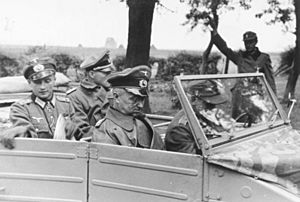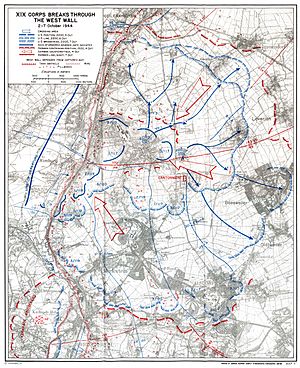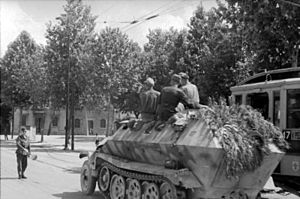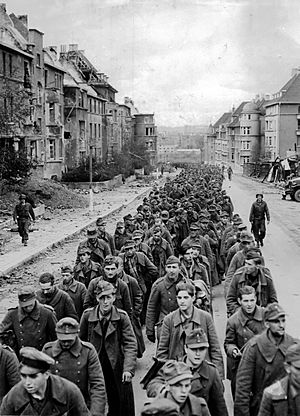Battle of Aachen facts for kids
Quick facts for kids Battle of Aachen |
|||||||
|---|---|---|---|---|---|---|---|
| Part of World War II | |||||||
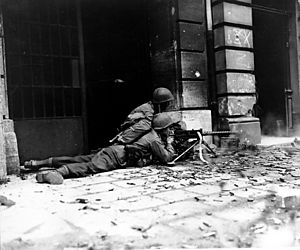 GI M1919 machine gun crew in action against German defenders in the streets of Aachen on 15 October 1944 |
|||||||
|
|||||||
| Belligerents | |||||||
| Commanders and leaders | |||||||
| Strength | |||||||
| 100,000 soldiers | 13,000 soldiers 5,000 Volkssturm |
||||||
| Casualties and losses | |||||||
| 5,000 casualties | 5,000 casualties 5,600 prisoners |
||||||
The Battle of Aachen was a very important battle during World War II. It took place in and around Aachen, Germany. American and German forces fought there from October 2 to October 21, 1944. Aachen was part of the Siegfried Line. This was Germany's main defense line on its western border. The Allies wanted to capture Aachen quickly. They hoped to then move into the Ruhr area, a big industrial region.
Most people living in Aachen left before the battle started. A large part of the city was destroyed. Both sides lost many soldiers. This battle was one of the biggest city fights for U.S. forces in World War II.
Aachen was the first German city captured by the Allies. The battle ended with Germany surrendering. However, their strong defense slowed down the Allies' plans to push further into Germany.
Contents
Why was Aachen important?
The Siegfried Line and Allied Plans
By September 1944, the Western Allies had reached Germany's western border. This border was protected by the Siegfried Line. It was a strong defense system. On September 17, British, American, and Polish forces tried to go around this line. They launched Operation Market Garden to cross the Lower Rhine River in the Netherlands.
This plan failed. Also, getting supplies to the front lines was hard because of the long distances. These problems stopped the Allied advance toward Berlin.
Germany had lost many soldiers in France. Their army was much weaker. This gave the Germans time to rebuild their forces. In September, new troops were sent to the Siegfried Line. They gathered 230,000 soldiers, including 100,000 new ones.
At the start of September, Germany had about 100 tanks in the West. By the end, they had 500. As more soldiers and equipment arrived, they built defenses that were about 3 miles (4.8 km) deep.
General Dwight D. Eisenhower led the Allied forces. He wanted to capture the Ruhr region. This was Germany's main industrial area. General Courtney Hodges's First Army was ordered to attack near Aachen.
Hodges first hoped to go around Aachen. He thought only a small group of soldiers defended it. He believed they would surrender once cut off.
Aachen's Symbolic Value
Aachen was an old, beautiful city. It was not a major target for war production. The Allies had not bombed its population of about 165,000 people.
However, Aachen was very important to the Nazi government and the German people. It was the first German city threatened by an enemy in World War II. It was also the historic capital of Charlemagne. He founded the "First Reich," an old German empire. This made the city very important to the Germans.
For the first time, German defenders were fighting on their home ground. One German officer said they felt like "German soldiers," not just Nazis.
Aachen was protected by the Siegfried Line. This system had many bunkers and forts. It also had anti-tank obstacles and barbed wire. In some areas, German defenses were over 10 miles (16 km) deep. It was one of the strongest defenses ever built.
Germans had learned from fighting on the Eastern Front. They placed defenses inside towns. They used narrow streets to make it hard for enemy tanks to move.
The troops defending Aachen were not the best. But the strong forts around Aachen were a big problem for the American forces. Getting through Aachen was important. The land beyond Aachen was flat, which was good for Allied armies to travel on.
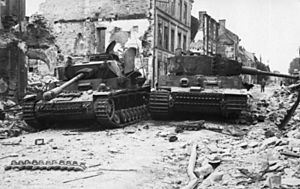
Fighting around Aachen began in the second week of September. The city was defended by the 116th Panzer Division. General Gerhard von Schwerin led them.
Allied forces were close, so most city officials left. (Hitler sent all Nazi officials who fled to the Eastern front as regular soldiers). Von Schwerin wanted to surrender the city. But on September 13, he was ordered to attack American forces southwest of Aachen. He attacked with his panzergrenadier troops.
The general's attempt to surrender angered Adolf Hitler. Hitler ordered his arrest. General Gerhard Wilck replaced him. The United States' VII Corps kept trying to get past German defenses.
Between September 14–16, the US 1st Infantry Division pushed forward. They faced strong defenses and attacks. They eventually surrounded half the city.
This slow advance stopped in late September. This was due to supply problems. Fuel and ammunition were sent for Operation Market Garden in the Netherlands instead.
Who Fought in the Battle?
German Defenders
In October, General Friedrich Köchling's LXXXI Corps defended Aachen. These forces had 20,000 men and 11 tanks. Köchling was also promised two more divisions with 24,000 troops.
The 183rd Volksgrenadier Division and 49th Infantry Division defended the north. The 12th Infantry Division was in the south. On October 7, the 1st SS Panzer Division Leibstandarte SS Adolf Hitler Panzer Division was sent to help.
German infantry divisions had about 15,000–17,000 soldiers at the start of World War II. By November 1944, this was down to about 8,761 men.
To deal with troop shortages, Volksgrenadier divisions were created in 1944. They had about 10,000 men each. About a quarter were experienced soldiers. The rest were new recruits, sick people, or from the air force and navy.
These divisions often had new small weapons. But they lacked artillery and vehicles. Many of their troops had very little training. However, the strong forts around Aachen made up for these weaknesses.
American Forces
General Charles H. Corlett's XIX Corps and Joseph Collins' VII Corps were tasked with capturing Aachen. This included the 30th Infantry Division and the 1st Infantry Division.
General Leland Hobbs' 30th Infantry Division got help from the 2nd Armored Division. Their sides were protected by the 29th Infantry Division.
In the south, the 1st Infantry Division was supported by the 9th Infantry Division and the 3rd Armored Division. These divisions received many new soldiers.
By October 1, over 70% of General Clarence Huebner's 1st Infantry Division were new troops. The last two weeks of September were spent training them.
The plan was for both infantry divisions to avoid fighting in the city streets. They would surround Aachen. Then a small force would capture it. Most US forces would move east.
American units usually got new troops quickly. But these new soldiers rarely had enough training. Many junior officers lacked leadership skills. Some tank drivers had never driven a car before. Some tank commanders had to teach their men how to use tank guns during missions.
This meant new troops were not ready for combat. Sometimes half of a unit's new soldiers were killed or wounded within days. These losses meant more troops were needed. A battalion from the US 28th Infantry Division helped the US 1st Infantry Division from October 18–21.
The Ninth Air Force supported these ground forces. They knew where most German bunkers were. They planned a first bombing with 360 bombers. New planes would be used for a second attack, including napalm.
Germany had few anti-aircraft guns. Their air force also offered little support. This meant Allied forces controlled the skies over Aachen.
The Battle Begins
For six days before the American attack, Allied artillery bombed German defenses. This stopped German troop and supply movements. But it did not destroy the strong German bunkers.
The air bombing on October 2 also did little damage. The 450 aircraft did not hit any German bunkers. Their targets were hidden by thick smoke from Allied artillery. After the planes, artillery fired 18,696 shells.
Pushing from the North: October 2–8
The 30th Infantry Division moved forward on October 2. They used artillery to destroy German bunkers. It took thirty minutes to capture one bunker. Heavy fighting was not expected. One group lost 87 soldiers in an hour. Another lost 93 out of 120 soldiers to German artillery.
The attackers slowly crossed the Wurm River. They attacked German bunkers with flamethrowers and explosives. By the afternoon of October 2, the 30th Infantry Division had gotten past German defenses. They reached the town of Palenberg.
Here, US soldiers fought for each house. (Private Harold G. Kiner won the Medal of Honor for jumping on a German grenade, saving two soldiers).
Fighting in Rimburg was terrible. American tanks could not cross the Wurm River. They could not support the infantry attacking the Germans. The 30th Infantry Division destroyed 50 German bunkers on the first day.
The 29th Infantry Division's attacks helped the advance. The Germans thought these were the main attack.
On the night of October 2, German tanks were ordered to attack the 30th Infantry Division. Allied artillery delayed the German attack. The German attack failed.
American tanks helped the advance on October 3. But German attacks stopped the US forces. Rimburg was captured on the second day. Fighting also began in Übach. American tanks tried to attack the town. But German artillery stopped them.
American artillery fire kept the Germans from recapturing Übach. By the end of the day, the 30th Infantry Division had about 300 dead and wounded.

German forces kept attacking Übach. This stopped American troops from moving forward. On October 4, the Allies had only captured Hoverdor and Beggendorf. The Americans lost 1,800 soldiers in three days. On October 5, the 119th Regiment of the 30th Infantry Division captured Merkstein-Herbach.
The next day, the Germans attacked Übach. But the attack failed. The Americans had many more tanks. The Germans did not have extra troops. General Koechling did get a Tiger tank group to defend Aachen from the north.
The Germans attacked on October 8 with an infantry regiment and 40 armored vehicles. The left side of the attack cut off an American platoon. The Germans had many losses. The Americans were getting closer.
Pushing from the South: October 8–11
In the south, the 1st Infantry Division attacked on October 8. They wanted to capture the town of Verlautenheide. A big artillery attack helped them capture the town.
By October 10, the 1st Infantry Division was in its planned position. From there, it could join with the 30th Infantry Division. The Germans attacked but lost over 40 soldiers and 35 were captured. Despite repeated German attacks, the 1st Infantry Division captured the high ground around the city.
On October 10, the US threatened to bomb the city if it didn't surrender. The German commander refused. American artillery fired 5,000 shells. American aircraft also bombed the city.
Joining Forces: October 11–16
American casualties were increasing. This was due to German attacks and the danger of attacking bunkers. Germans in Bardenberg built bunkers to defend themselves. American attackers pulled back and shelled the town with artillery.
On October 12, the Germans attacked the American 30th Infantry Division. The Americans defended with artillery and anti-tank weapons.
At Birk village, German tanks fought a single American Sherman tank. Then the 2nd Armored Division arrived. The Germans were pushed out of the town.
The 30th Infantry Division had to defend all the land they held. They were ordered to move south to join the 1st Infantry Division. Two infantry battalions from the 29th were sent to help the 30th.
On the same day (October 12), two German infantry regiments tried to recapture land. Both regiments were almost completely destroyed. Between October 11–13, Allied aircraft bombed Aachen.
On October 15, the Germans again attacked the 1st Infantry Division. Some heavy tanks broke through American lines. But most German forces were destroyed by artillery and planes.
The next day, the Germans attacked with the 3rd Panzergrenadier Division. They had heavy losses and had to stop.
The 30th Infantry Division and parts of the 29th Infantry and 2nd Armored divisions moved south between October 13–16. They could not get through German defenses to join Allied forces to the south.
The Germans attacked with artillery. German tanks were hidden in houses. General Hobbs, commander of the 30th Infantry Division, tried to go around the German defenses. He attacked with two infantry battalions. The attack worked. The 30th and 1st Infantry Divisions joined up on October 16.
The fighting caused American XIX Corps over 400 dead and 2,000 wounded. 72% were from the 30th Infantry Division. The Germans had 630 soldiers killed and 4,400 wounded. Another 600 were killed in the 3rd Panzergrenadier Division's attack on October 16.
The Fight for the City: October 13–21
The 1st Infantry Division had only one regiment to capture the city. They attacked with machine guns and flamethrowers. Only a few tanks and one howitzer were used.
About 5,000 German troops defended the city. This included navy, air force, and city police. Most of these soldiers lacked experience. They had some tanks and assault guns. However, Aachen's narrow streets helped the defenders.
The 26th Infantry's attack on October 13 was stopped by Germans firing from sewers and cellars. Sherman tanks could not move well in the narrow streets. The 26th Infantry Regiment used howitzers to destroy German defenses. German anti-tank guns attacked Sherman tanks.
American tanks and other armored vehicles shot at buildings to kill hidden defenders. German infantry moved through sewers to attack Americans.
The Germans fought very hard. They attacked the Americans and used tanks to stop American movement.
On October 18, the 3rd Battalion of the 26th Infantry Regiment prepared to attack the Hotel Quellenhof. This was one of the last areas held by the Germans. American tanks and guns fired at the hotel. That night, 300 new soldiers moved into the hotel. They stopped several attacks on the building.
A strong German attack got past American infantry outside the hotel. But American mortar fire stopped them.
The Americans shelled German positions with 155mm guns. A battalion of the 110th Infantry Regiment filled gaps in the city. This new battalion was told to attack the city on October 19–20.
On October 21, soldiers of the 26th Infantry Regiment captured central Aachen. The Germans in the Hotel Quellenhof surrendered. This ended the battle for the city.
Images for kids
See also
 In Spanish: Batalla de Aquisgrán para niños
In Spanish: Batalla de Aquisgrán para niños


